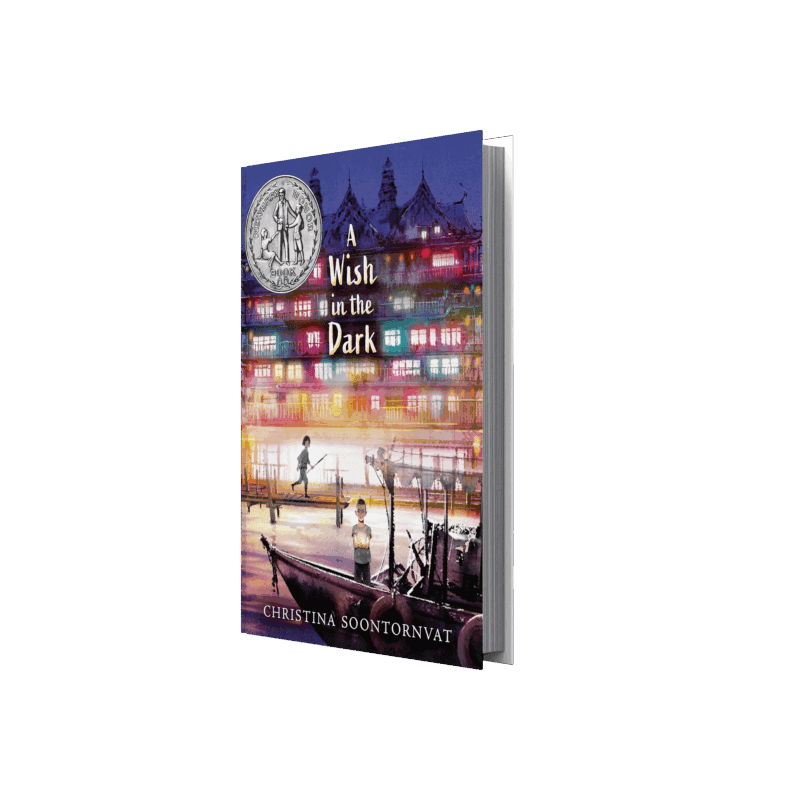— Christina Soontornvat, A Wish in the Dark
Middle Read Lakeshore 2025 Book
A Wish in the Dark
Christina Soontornvat

“You can't run away from darkness... It's everywhere. The only way to see through it is to shine a light.”
Book Summary
Christina Soontornvat's A Wish in the Dark is a luminous middle-grade fantasy set in the Thai-inspired city of Chattana, where light is controlled by the authoritarian Governor. The story follows Pong, a boy born in Namwon Prison, who escapes in search of freedom but finds a world outside that is just as unjust. Branded by his prison tattoo, Pong is pursued by Nok, the prison warden's daughter, determined to restore her family's honor. As their paths intertwine, both characters grapple with questions of morality, justice, and the true meaning of freedom. Inspired by Victor Hugo's Les Misérables, this novel explores themes of privilege, protest, and the power of individual courage to challenge systemic oppression. A Wish in the Dark has been recognized with a Newbery Honor and the Jane Addams Children's Book Award for its compelling narrative and profound social commentary.
About The Author
Christina Soontornvat

Christina Soontornvat is an award-winning author of books for children and young readers, celebrated for her ability to blend rich cultural storytelling with powerful themes of justice, identity, and resilience. Born in Texas to Thai immigrant parents, she grew up straddling two cultures, which has deeply influenced her writing. Before becoming a full-time author, Christina earned degrees in mechanical engineering and science education, and worked in science museums—experiences that often inspire the curiosity and wonder found in her books.
She is the author of numerous critically acclaimed works, including A Wish in the Dark, a Newbery Honor winner and Jane Addams Children’s Book Award recipient. Her nonfiction title All Thirteen: The Incredible Cave Rescue of the Thai Boys’ Soccer Team also received a Newbery Honor and was a finalist for the National Book Award. Christina continues to write stories that empower young readers, often weaving in elements of her Thai heritage, and she is recognized as a leading voice in contemporary children’s literature.
Reviews
“Soontornvat’s (The Blunders: A Counting Catastrophe!) twist on Les Misérables, set in an alternate Thai city, sends the young protagonists through lantern-soaked night markets; descriptions of food and place are particularly rich and evocative. Though Nok and Pong occupy the same spaces, there is relatively little interaction between them until two-thirds through the story. Instead, the plot’s emotional pull comes from their relationship with other characters, such as Pong’s connection with kindly monk Father Cham and Nok’s with her conflicted father. Soontornvat artfully builds up to a triumphant confrontation, weaving in important themes about oppression and civil disobedience along the way.”
Publisher’s Weekly
A Wish in the Dark
Discussion Questions
- “A monster of a mango tree” is introduced on the fi rst page of the book. How is it signifi cant? What part does it play in the story?
- Pong thinks it is worthwhile to fight for what’s right, even when it’s just a mango that should have been thiers, whereas Somkit thinks it’s more important to protect oneself. Which point of view resonates most with you? Why? Is one of them right and the other wrong?
- Pong struggles with being labeled as a criminal just because he was born in a prison. How does the novel challenge traditional ideas about justice and punishment?
- Pong was born in a prison, and Nok was raised by the Governor’s strict ideals. How do their environments shape their beliefs—and how do they begin to question those beliefs?
- Ampai says that “It’s the law, but it isn’t what’s right” (212). How are the law and what’s right different? Can you think of laws that don’t seem right to you?
- Both Father Cham and Ampai, the woman who organizes the resistance to the Governor, are elders who guide the younger people who live with them. How are they alike? How are they different?
- At first, light is seen as a gift from the Governor. But as the story unfolds, how does the meaning of light shift for different characters?
- After the Governor is gone, the people feel a little lost since there is no longer anyone telling them what to do. e author asks, “Which was better: being safe or having freedom? And did you have to choose?” (page 372). How would you answer this?
